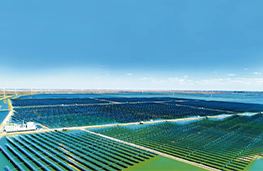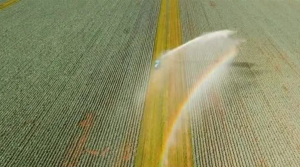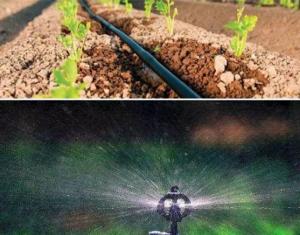With the rapid development of human society and the economy, the contradiction of water resources has become increasingly prominent, so the demand for rural water conservancy construction is increasing. Especially in arid areas, it is very necessary to use advanced water-saving technology to improve the operation and management of irrigation systems, while popularizing and improving the quality of high-efficiency agricultural production represented by water-saving irrigation. This automatic control and regulation technology and throttling irrigation technology have been widely used in agricultural production, laying a solid foundation for promoting its high efficiency and energy saving. This article aims to promote agricultural development in arid regions by analyzing the integrated application of advanced water-saving technologies and advanced automation technologies.

In modern agriculture, due to the increasingly obvious effect of irrigation technology on crops’ growth and utilization, automatic control technology in agricultural water saving has become an inevitable development direction. The automatic control of the irrigation area can maximize the use of the functions of the current economizer to achieve optimal drainage and the greatest economic benefits. Modern automatic control has already been implemented in many developed provinces and cities, and the technology has been quite mature and widely used. Relatively speaking, automatic irrigation in most arid areas is still in its infancy, and further experiments and promotions are yet to be done. Through the investigation and analysis of farmland water conservancy facilities, it is believed that the use of agricultural mechanization technology and automation technology can not only effectively achieve the effective use of water resources, but also effectively improve agricultural production and management. For this reason, it must be deeply discussed to ensure its normal operation in agricultural production in arid areas.
Agriculture is fundamental to solving people’s basic living security. In traditional society and the economy, agriculture plays an important driving force and core position, so we attach great importance to it. However, with the progress of human society, the progress of human science and technology, and the living and working conditions of human beings are also quietly changing. And in our country, more and more people pay attention to and realize the irrigation system of agriculture.
Everyone knows that in order to save and protect the ecology of the earth, we are now actively advocating water conservation and resource conservation, and have formulated many policies and regulations on water conservation. Under such a big environment, the agriculture of towns and villages has also responded to the government in a timely manner. According to the requirements of the country, advanced water-saving and flow-saving technologies are adopted to optimize the use of water in rural areas, thus enabling rapid development of rural agriculture. Therefore, the realization of agricultural mechanized irrigation is an inevitable trend, which will have a positive impact on human survival and development.
In the corresponding development process, it is necessary to integrate efficient water-saving irrigation with modern automated management, so that rural agricultural production can adapt to the development of the times, walk at the forefront of society, and play its important promotion and significance.
We all know that agricultural development has effectively promoted social and economic development, so relevant agricultural technologies have been deeply researched and applied in many aspects. According to relevant data, many farmland water conservancy technologies in China have adopted relatively mature technologies. Compared with conventional flood irrigation, it can not only save a lot of water but also effectively improve the quality of grain and increase production. Especially after the new century, the rapid development of agricultural technology and the increasing application of mechanization have provided new opportunities for agricultural development. How integrate high-efficiency water saving and modern automation management is an inevitable requirement to adapt to the development of the times and promote social and economic development.

At present, mechanized water-saving technology has been popularized and applied in agriculture in some arid areas, and has achieved good results. It has improved the efficient operation of agriculture, promoted the steady development of the rural economy, and promoted the rational use of water resources.
At present, there are three types of high-efficiency water-saving irrigation technologies used in arid areas: pipe irrigation, sprinkler irrigation, and micro-irrigation. These methods are widely used in irrigation areas at present, and the characteristics of the irrigation area are quite different from the previous flood irrigation. The form of the irrigation area usually adopted should be determined according to the situation. First, the application of pipeline irrigation technology. Tubular grouting, pouring water through a pipe, replaces the previous channel. When pipe irrigation technology is used for related agricultural irrigation, the water supply can be directly sent to the required water source through the pressure pipeline system.
Pipeline irrigation is usually used, which has the advantages of simple structure, easy operation, small investment, and high utilization rate of water resources. Second, its characteristics are how to use sprinkler irrigation technology uses pumping and pressurization, and special devices, such as nozzles, to sprinkle water into the irrigation area in the form of water droplets. In general, spraying technology is suitable for different terrains and different lands, and it can properly irrigate crops and has the characteristics of water saving and uniform irrigation. Third, micro-irrigation technology was adopted.
According to the needs of the crops, a special aggregator is used to irrigate water and nutrients to the soil around the crop root system or into the soil in a specific way. Generally speaking, it can be divided into several types such as drip irrigation, seepage irrigation, and micro-sprinkler irrigation, which are characterized by energy saving and strong adaptability. In the process of agricultural irrigation, drip irrigation under mulch is used as the main method, and its design principle is central operation monitoring and decentralized operation.
Therefore, in terms of drip irrigation system design, pipe network layout, etc., the better optimal configuration will be obtained, so that the irrigation volume of each irrigation area will be more balanced, so as to achieve the maximum realization of mechanized drip irrigation, thereby saving irrigation costs, improving irrigation quality, The purpose of increasing irrigation efficiency.

The automatic control irrigation method can effectively control the pipeline pressure, irrigation water volume, irrigation time, air humidity, soil humidity, water level, etc. Usually, when the operation is carried out in an automated manner, the state of opening and closing the system should be set during the operation of the system, and the operation should be carried out when a certain amount reaches a certain level. In addition, the automatic irrigation device can also send information remotely, and through the Internet and other equipment, it can monitor the planting situation of the farmland in real-time, so as to make accurate decisions and adjustments. In practical applications, multiple physical parameters are usually used.
Therefore, according to the method of irrigation, different irrigation methods can be selected, such as pipe grouting, pipe pressure and time, pipe pressure and irrigation volume, pipe pressure, and ground level, and the two irrigation methods of spraying and dripping are different from traditional pipe irrigation. The way is different. In short, in agricultural production, the application of water-saving technology has realized the automatic control from conventional full irrigation to incomplete irrigation and realized the real-time dynamic management of real-time monitoring, forecasting, and implementation of water use in irrigation areas. Use sensors to monitor the water content of farmland and the growth and development of crops in real-time, so as to achieve automatic control of water resources.
Through relevant research and research, it is believed that the use of automated irrigation technology can promote the growth and development of crops. When conducting experiments, different methods are used to control different soil conditions in different regions. That is to say, automatic irrigation can flexibly adjust the irrigation method according to the needs of different crops and can monitor soil, air, humidity, and other parameters in real-time, so as to achieve automatic water-saving irrigation.
The application results show that this technology can well meet the needs of current irrigation production, and it is a promising new type of irrigation equipment. In the dispatching center, the operating personnel realized the time-sharing rotation irrigation of the automatic irrigation area through the comprehensive analysis of the meteorological data and the soil moisture in the field. And use the data query and printing function, record queries at any time, print out meteorological data, soil humidity, irrigation device, irrigation process, irrigation history, and other information.
The automatic, timely, and moderate irrigation and management of the irrigation system, not only saves the cumbersome process of manually opening and closing the valve, but also greatly reduces the labor intensity, improves work efficiency, and implements precision irrigation, making drip irrigation, advanced irrigation The scientific and technological content of the technology has been further improved.
In general, in order to continue to develop agriculture in dry areas, it must be integrated with modern science and technology. To this end, it is necessary to carry out technical reforms, organically integrate high-efficiency water-saving and modern mechanized management, effectively promote the development of agriculture, and achieve good application results.